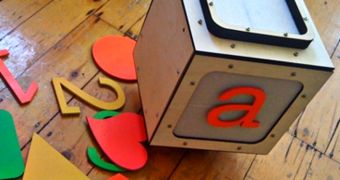While looking at what TV and computers have to provide to children in terms of education, researchers at MIT found that both forms of media left kids stationary in front of a screen. So they decided to create a device that literally made children get up and move.
What they came up with is something called the Playtime Computing system, which contains several separate, yet integrated components. The centerpiece is a block-shaped robot called the Alphabot, which can move from the real to the virtual world and vice-versa.
The educational-media system is made up of three door-high panels, each of which is illuminated by a projector located in the back. Two image projectors are mounted on the ceiling, and they are used to project video on the ground in front of the panels.
Then there's the Alphabot, which is a cube-shaped, remote-controlled robot that can navigate on the floor. It has infrared emitters on all of its corners, which allow for wall-mounted cameras to track its movements on the floor.
But what is really remarkable about this system is that the distinction between the real and virtual components making it up simply disappears at one point. This is done by installing a trap door in one of the panels, through which Alphabot disappears.
As this happens, the virtual representation of the robot appears on-screen, and it continues trekking in whatever landscape is being projected. The trap door behind it closes automatically, so children will believe that the cube went into the screen.
The Playtime Computing system was developed by scientists at the Massachusetts Institute of Technology (MIT) Media Laboratory, who were led by professor Cynthia Breazeal of the Personal Robotics Group.
“We kind of see it as one reality. One of the things we’re really excited about is having two of these spaces, one here and maybe one in Japan, and when the robot goes into the virtual world here, it comes out of the virtual world in Japan,” explains Adam Setapen.
He is a graduate student in Breazeal's group, and one of the researchers who helped design the system. “So that kind of fits in with that one-reality concept, that there’s one robot, and whether it’s physical or virtual is based on the state of the robot in the Playtime Computing system,” he adds.
“We like the idea of this big space that they can run around in, and be active, and be kids, because that’s a big part of how they learn, by moving around and interacting with each other,” the student adds.
“Childhood obesity is a serious problem. Michelle Obama has this whole campaign called Let’s Move to promote more-active play,” adds MIT graduate student David Robert, who is also a member of the science team.
At this point, the system is fairly limited, in the sense that it can only work with specific components. It can only recognize characters that the system comes integrated with.
In practical trials, children placed all sorts of things on the Alphabot, and the machine was unable to recognize them. The investigators are now working on developing a way of making the robot capable of identifying a host of objects placed in its special slot.
“We would love it if the kid could take their favorite toy and put it in the hutch, and then a digital model of the toy appears on the screen. It doesn’t get that much better for kids,” Setapen concludes.

 14 DAY TRIAL //
14 DAY TRIAL //